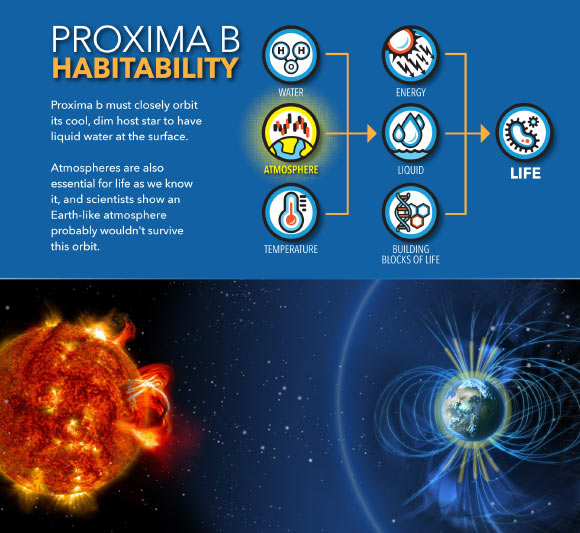According to new research from NASA scientists, Proxima b may not be able to keep a grip on its atmosphere, leaving the surface exposed to harmful radiation.

This artist’s impression shows Proxima b orbiting Proxima Centauri, which at only 4.23 light-years is the closest star to our Solar System. The double star Alpha Centauri AB also appears in the image between the exoplanet and Proxima itself. Image credit: M. Kornmesser / ESO.
Proxima b was discovered in 2016 by a research team led by Queen Mary University astronomer Dr. Guillem Anglada-Escudé.
The planet orbits Proxima Centauri, a red dwarf star only 4.23 light-years away in the constellation Centaurus.
It is slightly larger than Earth and sits within its host star’s habitable zone, where liquid water could theoretically exist on the surface.
Due to the fact that Proxima b hasn’t been seen crossing in front of Proxima Centauri, the planet eludes the usual method for learning about its atmosphere.
Instead, astronomers must rely on models to understand whether the planet is habitable.
One such computer model considered what would happen if Earth orbited Proxima Centauri at the same orbit as Proxima b.
The study suggests Earth’s atmosphere wouldn’t survive in close proximity to the violent red dwarf star.
“We decided to take the only habitable planet we know of so far — Earth — and put it where Proxima b is,” said Katherine Garcia-Sage, a space scientist at NASA’s Goddard Space Flight Center.
The team’s model used Earth’s atmosphere, magnetic field and gravity as proxies for Proxima b’s.
The scientists also calculated how much radiation the parent star produces on average, based on observations from NASA’s Chandra X-ray Observatory.
With these data, the model simulates how the host star’s intense radiation and frequent flaring affect the planet’s atmosphere.
“The question is, how much of the atmosphere is lost, and how quickly does that process occur? If we estimate that time, we can calculate how long it takes the atmosphere to completely escape — and compare that to the planet’s lifetime,” said co-author Dr. Ofer Cohen, a space scientist at the University of Massachusetts, Lowell.
The computer model shows Proxima Centauri’s powerful radiation drains the Earth-like atmosphere as much as 10,000 times faster than what happens at Earth.
“This was a simple calculation based on average activity from the host star,” Dr. Garcia-Sage said.
“It doesn’t consider variations like extreme heating in the star’s atmosphere or violent stellar disturbances to the planet’s magnetic field — things we’d expect provide even more ionizing radiation and atmospheric escape.”

At its orbit, Proxima b likely couldn’t sustain an Earth-like atmosphere. Image credit: NASA’s Goddard Space Flight Center / Mary Pat Hrybyk-Keith.
To understand how the process can vary, the researchers looked at two other factors that exacerbate atmospheric loss.
First, they considered the temperature of the neutral atmosphere, called the thermosphere. They found as the thermosphere heats with more stellar radiation, atmospheric escape increases.
They also considered the size of the region over which atmospheric escape happens, called the polar cap.
Planets are most sensitive to magnetic effects at their magnetic poles. When magnetic field lines at the poles are closed, the polar cap is limited and charged particles remain trapped near the planet. On the other hand, greater escape occurs when magnetic field lines are open, providing a one-way route to space.
“This study looks at an under-appreciated aspect of habitability, which is atmospheric loss in the context of stellar physics,” said Goddard space scientist Dr. Shawn Domagal-Goldman, who was not involved in the study.
“Planets have lots of different interacting systems, and it’s important to make sure we include these interactions in our models.”
The study shows that with the highest thermosphere temperatures and a completely open magnetic field, Proxima b could lose an amount equal to the entirety of Earth’s atmosphere in 100 million years – that’s just a fraction of Proxima b’s 4 billion years thus far.
When the authors assumed the lowest temperatures and a closed magnetic field, that much mass escapes over 2 billion years.
“Things can get interesting if an exoplanet holds on to its atmosphere, but Proxima b’s atmospheric loss rates here are so high that habitability is implausible,” said co-author Dr. Jeremy Drake, an astrophysicist at the Harvard-Smithsonian Center for Astrophysics.
“This questions the habitability of planets around such red dwarfs in general.”
The research is published in the Astrophysical Journal Letters.
_____
K. Garcia-Sage et al. 2017. On the Magnetic Protection of the Atmosphere of Proxima Centauri b. ApJL 844, L13; doi: 10.3847/2041-8213/aa7eca
This article is based on text provided by the National Aeronautics and Space Administration.







